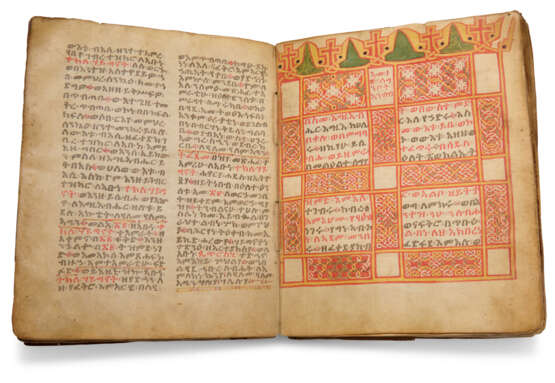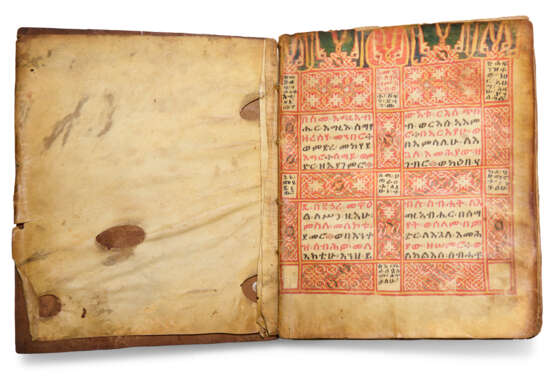ID 1214843
Лот 61 | Lives and Miracles from Däbrä Libanos
Оценочная стоимость
£ 10 000 – 15 000
Life and Miracles of Märha Krestos; Miracles of Täklä Haymanot in three sections; and the Passion of Filepp'os of Däbrä Asbo [Däbrä Libanos], in Ge'ez, decorated manuscript on vellum, Ethiopia, Monastery of Däbrä Libanos [1497-1508].
A remarkable collection of the Lives, Miracles and a Passion celebrating the three most famous abbots from Däbrä Libanos, Ethiopia's premier monastery. Commissioned by the abbot Abunä P’ēt’ros, successor to Märha Krestos, written at the monastery of Däbrä Libanos between 1497-1508.
275 x 225mm. 176 leaves, complete, mostly in gatherings of 8, two columns of 23 lines, written in black ink in Ge'ez in an elegant, square script, original pricking and ruling visible throughout, six full-page harägs, or ornamental and identical cruciform structures framing the prologues of each of the major text divisions. Bound between plain wooden boards (the back board now split and repaired). Fitted box.
Provenance:
(1) Colophons scattered throughout the text ascertain with precision a composition date between 1497 and 1508, commissioned by Abunä P’ēt’ros, the abbot successor to Märha Krestos (1408-1497) at the monastery of Däbrä Libanos. The text of the Life of Märha Krestos and his Miracles was written and composed by Ferē Qeddus at the monastery of Däbrä Libanos. David Appleyard places the script firmly within the middle of Uhlig's Period III, in keeping with a date c.1500.
(2) Wälättä Ab of Emmäyät Sheffen (i.e. the parish of the Church of Our Lady at Sheffen) in the district of Gwacha, donated to:
(3) Täklä Hyamanot and Filepp'os (i.e. most likely to the monastery at Däbrä Libanos).
(4) A’edäwä Krestos together with his wife, Maryamawit, and his son, Qērellos. The records which identify at least these two subsequent owners (A’edäwä Krestos and Wälättä Ab of Emmäyät Sheffen) and the manuscript's return to the monastery appear in later additions to the harägs or the endnotes. These additions are in a much later hand than the manuscript itself, possibly datable to the second half of the 18th century. It is furthermore impossible to determine with certainty the sequence of ownership from the annotations.
(5) Nîmes, Dolo Collection, according to a catalogue note in French included in the consignor's bibliographical records.
(6) Sam Fogg, London, acquired in 1996 by:
(7) The Schøyen Collection, MS 2258.
Contents:
Blank f.1; Prologue to the first set of the Miracles of Täklä Haymanot, framed in a fine and intricate haräg, beginning 'In the name of the Lord God who made heaven his seat and carth his walking place', f.2; Introduction to the first set of the Miracles of Täklä Haymanot, beginning 'We shall write therefore how today on this day it is [the feast of] the birth of our father Täklä Haymanot', ff.2v-8; 22 Miracles of Täklä Haymanot, ff.8-26v; Prologue to the Passion of Filepp'os, framed within a similar cruciform haräg to f.2, beginning 'In the name of the Lord God Sabaoth, whose holy praises fill heaven and earth', f.27; The Passion of of Filepp'os, beginning 'We shall write therefore how today this day is [the feast of] the death of our father Fileppo'os, martyr combatant and excellent in perfection', ff.27v-36v; Prologue to the second set of Miracles of Täklä Haymanot, framed in the usual cruciform haräg, beginning 'In the name of God reigns over all, who raised him up from earth to heaven', f.37; Introduction to the second set of Miracles of Täklä Haymanot, beginning 'We shall write therefore that today on this was conceived our father Täklä Haymanot', ff.37v-39v; 22 Miracles of Täklä Haymanot, ff.39v-47v; Prologue to the third set of Miracles of Täklä Haymanot, framed in the usual cruciform haräg, beginning 'In the name of God, mighty in His word and His deeds, whom those who dwell in the heights of heaven and on earth praise and laud', f.48; Introduction to the third set of Miracles of Täklä Haymanot, beginning 'Let us write therefore that today on this day was the death of our father Täklä Haymanot', ff.48v-50; 22 Miracles of Täklä Haymanot, ff.50-62; Prologue to the Life of Märha Krestos, framed in the usual cruciform haräg, beginning 'In the name of God the Father who is sender, and in the name of God the Son who is sent', f.63; The Life of Märha Krestos, beginning 'Let us proceed through the help of God, as Peter chief of the Apostles said', ff.63v-154; Prologue to the Miracles of Märha Krestos, framed in the usual cruciform haräg, beginning 'In the name of God, the Lord Adonay, who first made the heavens and the earth was originally invisible', f.155; Introduction to the Miracles of Märha Krestos, beginning 'We shall write therefore how our father Märha Krestos performed miracles and wonders', ff.155v-157; 22 Miracles of Märha Krestos, ff.157-176; a colophon stating that 'This is the composition of Ferē Qeddus, son of Märha Krestos, [in] which he wrote how our father Täklä Haymanot was conceived [...]', f.176v.
The manuscript recounts the lives, miracles and passions of three of Ethiopia's most important religious figures: Täklä Haymanot, Fileppo's, and Märha Krestos. Respectively the first, third, and ninth abbots of the monastery of Däbrä Asbo in Shoa (renamed Däbrä Libanos in the fifteenth century by the Emperor of Ethiopia Zär’a Ya’eqob (1399-1468)), these three abbots were known as Ech’āgē, ranked second in the hierarchy of the Ethiopian Orthodox Church only after the Abun, the Bishop and now Patriarch of Ethiopia.
The first half of the manuscript recounts three sets of 22 miracles each of Saint Täklä Haymanot (c.1215-1313), associated with the feast days celebrating his birth, conception, and death respectively. Täklä Haymanot founded the community at Däbrä Asbo in about 1284; the accounts of his miracles reveal the fervour of his missionary activities in Shoa and Damot. He was directly responsible for much of the evangelisation of what is now central and south-central Ethiopia and is considered today to be Ethiopia's premier indigenous saint.
The account of the Passion of Fileppo's in the present manuscript inserts itself between the first and second set of Täklä Haymanot's miracles. Fileppo's became the third abbot of Däbrä Asbo shortly after Täklä Haymanot's death in 1313, instigating the growth of Däbrä Asbo into a monastic centre of great importance in the history of the Ethiopian Church. But the simultaneous growth of the monastery's political influence saw the abbot frequently come into conflict with the emperors; he was relieved of the abbacy in 1341 and exiled to Tegrē, before being recalled to the court of Abunä Sälama (1348-1388) where he later died in 1354.
The second, larger half of the manuscript details the Life and then the Miracles of Märha Krestos (1408-1497), the ninth abbot of Däbrä Libanos. His accession to the abbacy in 1467 followed a prolonged period of political and religious conflict between the emperors and the monastic community, which saw his predecessor, the eighth Abbot Endreyas, put to death by the Emperor Zär’a Ya’eqob. A politically astute religious leader, he actively supported the religious reforms of three successive emperors and aligned the monastery with the favour of the court. He played pivotal roles in fundamental questions of Ethiopian religious/political Orthodoxy, supporting the Emperor in maintaining the Alexandrian (and hence Egyptian, as opposed to native Ethiopian) election of the head of the Ethiopian Church, the Abun. Märha Krestos was the premier Ethiopian religious dignitary advising the Ethiopian emperors in the fifteenth century; the details of his life are known almost exclusively from the Life.
All three texts are extant in other records: the text of the various miracles of Täklä Haymanot, including the prologues and introductions, is identical to item no 2134 of the Ethiopian Manuscript Microfilm Library project; published translations of the miracles can be found in E. Wallis Budge, The Life of Takla Hâymânot in the Version of Dabra Libânos and the Miracles Takla Hâymânot in the Version of Dabra Libânos (London, 1906). The Life and Miracles of Märha Krestos were published and translated in the CSCO series by Stanislas Kur, based on Rome, Biblioteca Apostolica Vaticana, Cerulli Etiopico 247; the manuscript at the Vatican does not contain the Passion of Fileppo's.
This catalogue note is based on extensive and comprehensive cataloguing of the manuscript by David Appleyard. For the full report, please apply to the department.
Literature
L’Arche Éthiopienne, art chrétien d’Éthiopie, Pavillon des Arts, Paris, 27 Sep. 2000 - 7 Jan. 2001 & Fundació Caixa de Girona, Spain, 23 Jan. - 31 Mar. 2001.
| Место происхождения: | Африка |
|---|---|
| Категория аукционного дома: | Манускрипты Средневековья и Ренессанса, Книги и рукописи |
| Место происхождения: | Африка |
|---|---|
| Категория аукционного дома: | Манускрипты Средневековья и Ренессанса, Книги и рукописи |
| Адрес торгов |
CHRISTIE'S 8 King Street, St. James's SW1Y 6QT London Великобритания | |
|---|---|---|
| Предосмотр |
| |
| Телефон | +44 (0)20 7839 9060 | |
| Комиссия | see on Website | |
| Условия использования | Условия использования |











